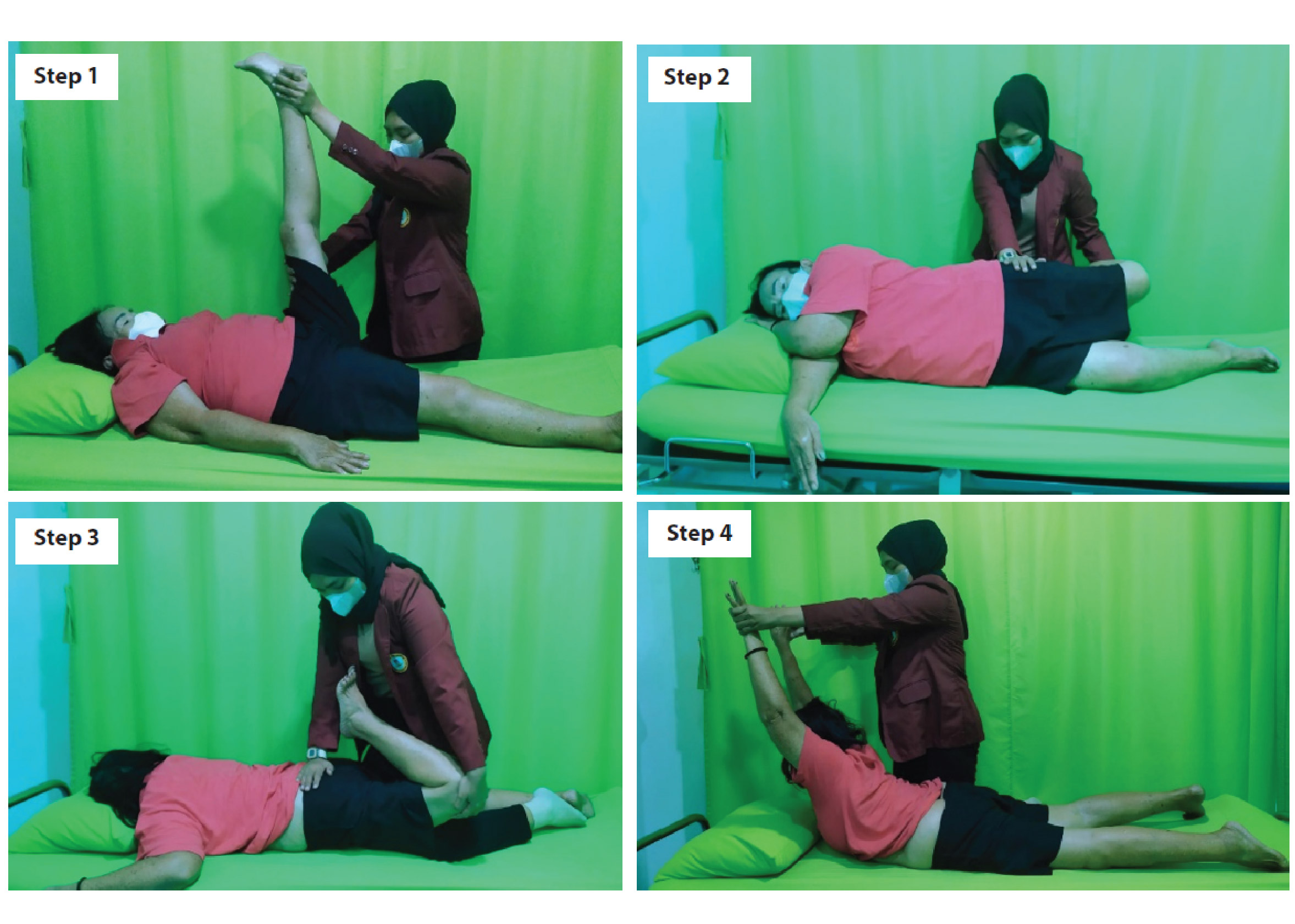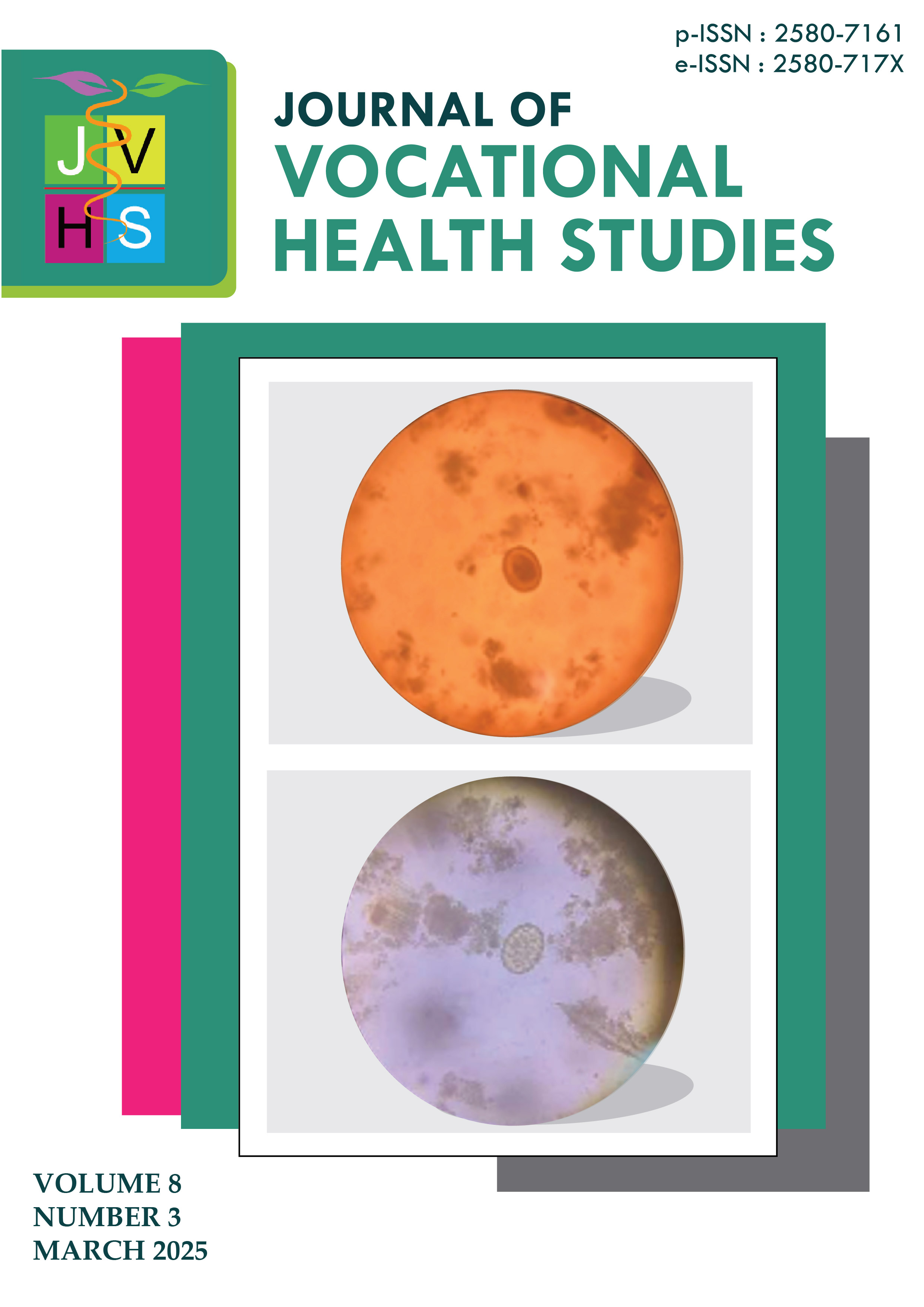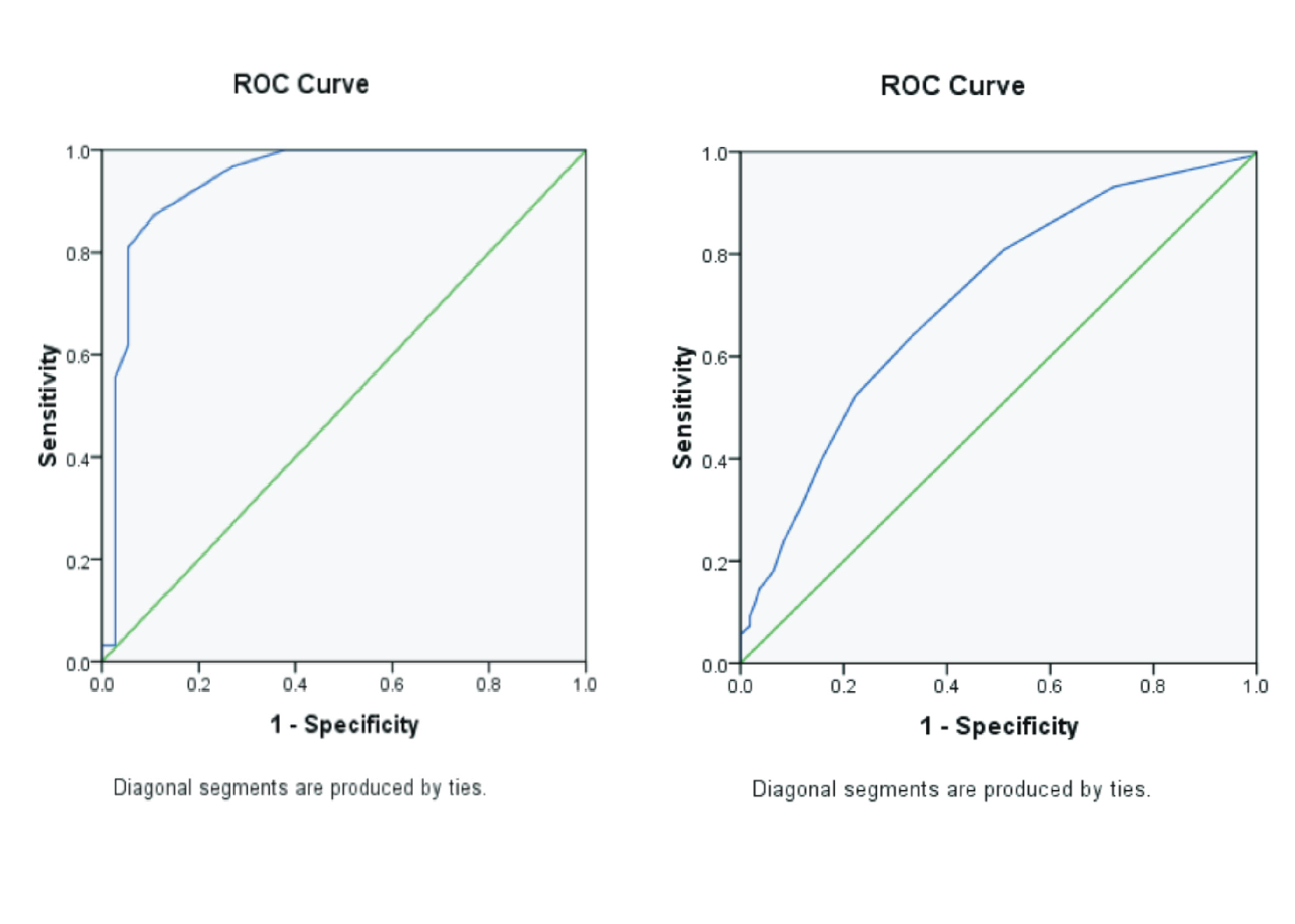A COMPARATIVE STUDY OF PHYSIOTHERAPY OUTCOMES BETWEEN INFRARED-TENS COMBINATION AND PNF THERAPIES IN NPH PATIENTS

Background: The pain experienced by Nucleus Pulposus Herniation (NPH) patients can have an impact on productivity and may lead to disability. Therefore, non-pharmacological therapies can serve as alternatives in reducing pain levels for Grade I and Grade II NPH patients. Purpose: To compare the difference in effectiveness between infrared-transcutaneous electrical nerve stimulation (IR-TENS) combination and Proprioceptive Neuromuscular Facilitation (PNF) therapies in reducing pain among NPH patients. Method: This research employed a quasi-experimental design with a two-group pretest-posttest design conducted at the Physical Medicine and Rehabilitation Unit of Royal Prima Hospital in Medan. A total of 20 NPH patients were provided with interventions, consisting of a combination of IR and TENS therapies for 10 patients, and PNF therapy for the other 10 patients, administered eight times for one month. Pain measurement was conducted using a Visual Analogue Scale (VAS) questionnaire before and after the interventions. The statistical analysis employed an Independent Sample T test, with a significance level (α) set at 0.05. Result: There was a reduction in moderate and severe pain scales in both groups, and no subjects were experiencing severe pain anymore. However, the reduction in moderate pain scale was higher in the group receiving the combination of infrared and TENS therapies (80%) compared to the PNF therapy (70%). The Independent T test showed that there was no significant difference between the effectiveness of the combination of IR-TENS therapies and PNF therapy on pain in NPH patients (p-value = 0.075). Conclusion: Both groups of patients experienced a reduction in pain scale after the interventions, although there was no significant difference in the outcome between the two treatment groups. This implies that both therapies are equally effective in suppressing pain in NPH patients.
Ahsan, M.K., Matin, T., Ali, M.I., Ali, M.Y., Awwal, M.A., Sakeb, N., 2013. Relationship between Physical Work Load and Lumbar Disc Herniation. Mymensingh Medical Journal: MMJ Vol. 22(3), Pp. 533-540.
Alentado, V.J., Lubelski, D., Steinmetz, M.P., Benzel, E.C., Mroz, T.E., 2014. Optimal Duration of Conservative Management Prior to Surgery for Cervical and Lumbar Radiculopathy: A Literature Review. Global Spine Journal Vol. 4(4), Pp. 279-286.
Altun, I., Yüksel, K.Z., 2017. Lumbar Herniated Disc: Spontaneous Regression. The Korean Journal of Pain Vol. 30(1), Pp. 44-50.
American Physical Therapy Association, 2000. Electrotherapeutic Terminology in Physical Therapy. American Physical Therapy Association.
Anekwu, E., 2015. Efficacy of Six Weeks Infrared Radiation Therapy on Chronic Low back Pain and Functional Disability in National Orthopaedic Hospital, Enugu, South East, Nigeria. The Nigerian Health Journal Vol. 15(4), Pp.155–160.
Ansari, N.N., Naghdi, S., Naseri, N., Entezary, E., Irani, S., Jalaie, S., Hasson, S., 2014. Effect of Therapeutic Infra-Red in Patients with Non-Specific Low Back Pain: A Pilot Study. Journal of Bodywork and Movement Therapies Vol. 18(1), Pp. 75-81.
Areeudomwong, P., Wongrat, W., Neammesri, N., Thongsakul, T., 2017a. A Randomized Controlled Trial on The Long-Term Effects of Proprioceptive Neuromuscular Facilitation Training, on Pain-Related Outcomes and Back Muscle Activity, in Patients with Chronic Low Back Pain. Musculoskeletal Care Vol. 15(3), Pp. 218-229.
Barolla, I., Paliyama, M., Huwae, L., 2021. Perbandingan Efek Terapi Transcutaneus Electrical Nerve Stimulation dan Infra Red dengan Infra Red dalam Pengurangan Nyeri Pada Penderita Ischialgia di RSUD dr. M. Haulussy Ambon. PAMERI: Pattimura Medical Review Vol. 3, Pp. 1-7.
Barreto, T., Lin, K., 2017. Noninvasive Treatments for Low Back Pain. American Family Physician.
Benoist, M., 2002. The Natural History of Lumbar Disc Herniation and Radiculopathy. Joint Bone Spine Vol. 69(2), Pp. 155-160.
Billy, G.G., Lemieux, S.K., Chow, M.X., 2014. Changes in Lumbar Disk Morphology Associated with Prolonged Sitting Assessed by Magnetic Resonance Imaging. PM R Vol. 6(9), Pp. 790-795.
Budiono, A., 2016. Pengaruh Latihan Proprioceptive Neuromuscular Facilitation (PNF) Pasca Cedera Bahu terhadap Perbaikan Range of Motion (ROM). Universitas Negeri Yogyakarta.
Chou, R., Deyo, R., Friedly, J., Skelly, A., Hashimoto, R., Weimer, M., Fu, R., Dana, T., Kraegel, P., Griffin, J., Grusing, S., Brodt, E., 2016. Noninvasive Treatments for Low Back Pain, AHRQ Comparative Effectiveness Reviews. Agency for Healthcare Research and Quality (US), Rockville (MD).
Citko, A., Górski, S., Marcinowicz, L., Górska, A., 2018. Sedentary Lifestyle and Nonspecific Low Back Pain in Medical Personnel in North-East Poland. BioMed Research International Pp. 965807.
De Decker, S., Fenn, J., 2018. Acute Herniation of Nondegenerate Nucleus Pulposus. The Veterinary Clinics of North America: Small Animal Practice Vol. 48(1), Pp. 95–109.
Dwi, W., M, M., Fauziah, E., 2020. Penatalaksanaan Fisioterapi untuk Gangguan Fungsional Lumbal pada Kasus Hernia Nukleus Pulposus dengan Teknik PNF, Tens, dan Mckenzie Exercise di RSUD Ulin Banjarmasin Tahun 2019. Jurnal Kajian Ilmiah Kesehatan dan Teknologi Vol. 2(1), Pp. 6-14.
Dydyk, A.M., Ngnitewe Massa, R., Mesfin, F.B., 2024. Disc Herniation. StatPearls Publishing, Treasure Island (FL).
Gale, G.D., Rothbart, P.J., Li, Y., 2006. Infrared Therapy for Chronic Low Back Pain: A Randomized, Controlled Trial. Pain Research & Management Vol. 11(3), Pp.193-196.
Gao, P., Tang, F., Liu, W., Mo, Y., 2022. The Effects of Proprioceptive Neuromuscular Facilitation in Treating Chronic Low Back Pain: A Systematic Review and Meta-Analysis. Journal of Back and Musculoskeletal RehabilitationVol. 35(1), Pp. 21-33.
Ginting, F.P., Susilo, T., 2022. Penatalaksanaan Fisioterapi pada Hernia Nukleus Pulposus Lumbal dengan Modalitas Infra Red, TENS dan MC Kenzie Exercise. Jurnal Gentle Birth Vol. 5(1), Pp. 74–80.
Gladwell, P.W., Badlan, K., Cramp, F., Palmer, S., 2015. Direct and Indirect Benefits Reported by Users of Transcutaneous Electrical Nerve Stimulation for Chronic Musculoskeletal Pain: Qualitative Exploration Using Patient Interviews. Physical Therapy Vol. 95(11), Pp. 1518-1528.
Gordon, R., Bloxham, S., 2016. A Systematic Review of the Effects of Exercise and Physical Activity on Non-Specific Chronic Low Back Pain. Healthcare (Basel) Vol. 4(2), Pp. 22.
Hasesa, F., 2022. Penatalaksanaa Hernia Nucleus Pulposus dengan Infra Red, Transcutaneous Electrical Nerve Stimulation, dan McKenzie Exercise (Skripsi). Universitas Widya Husada Semarang.
Health Research and Development, 2020. Laporan Nasional Riskesdas 2018. Lembaga Penerbit Badan Penelitian dan Pengembangan Kesehatan, Jakarta.
Hindle, K.B., Whitcomb, T.J., Briggs, W.O., Hong, J., 2012. Proprioceptive Neuromuscular Facilitation (PNF): Its Mechanisms and Effects on Range of Motion and Muscular Function. Journal of Human Kinetics Vol. 31, Pp. 105-113.
Jauregui, J.J., Cherian, J.J., Gwam, C.U., Chughtai, M., Mistry, J.B., Elmallah, R.K., Harwin, S.F., Bhave, A., Mont, M.A., 2016. A Meta-Analysis of Transcutaneous Electrical Nerve Stimulation for Chronic Low Back Pain. Surgical Technology International Vol. 28, Pp. 296-302.
Kofotolis, N., Kellis, E., 2006. Effects of Two 4-Week Proprioceptive Neuromuscular Facilitation Programs on Muscle Endurance, Flexibility, and Functional Performance in Women with Chronic Low Back Pain. Physical Therapy Vol. 86(7), Pp. 1001-1012.
Lan, F.-Y., Liou, Y.-W., Huang, K.-Y., Guo, H.-R., Wang, J.-D., 2016. An Investigation of A Cluster of Cervical Herniated Discs among Container Truck Drivers with Occupational Exposure to Whole‐Body Vibration. Journal of Occupational Health Vol. 58(1), Pp. 118-127.
Li, Y., Shi, J.-J., Ren, J., Guan, H.-S., Gao, Y.-P., Zhao, F., Sun, J., 2020. Relationship Between Obesity And Lumbar Disc Herniation In Adolescents. Zhongguo Gu Shang Vol. 33(8), Pp. 725-729.
Nordberg, C.L., Boesen, M., Fournier, G.L., Bliddal, H., Hansen, P., Hansen, B.B., 2021. Positional Changes in Lumbar Disc Herniation During Standing or Lumbar Extension: A Cross-Sectional Weight-Bearing MRI Study. European Radiology Vol. 31(2), Pp. 804-812.
Ojeniweh, O.N., Ezema, C.I., Okoye, G.C., 2019. Efficacy of Infrared Radiation Therapy on Chronic Low Back Pain: A Case Study of National Orthopaedic Hospital, Enugu, South East, Nigeria. International Journal of Basic, Applied and Innovative Research Vol. 7, Pp.107–114.
Pop, T., Austrup, H., Preuss, R., Niedziałek, M., Zaniewska, A., Sobolewski, M., Dobrowolski, T., Zwolińska, J., 2010. Effect of TENS on Pain Relief in Patients with Degenerative Disc Disease in Lumbosacral Spine. Ortopedia, Traumatologia, Rehabilitacja Vol. 12(4), Pp. 289-300.
Schroeder, G.D., Guyre, C.A., Vaccaro, A.R., 2016. The Epidemiology and Pathophysiology of Lumbar Disc Herniations. Seminars in Spine Surgery, Lumbar Disc Herniation Vol. 28(1), Pp. 2-7.
Siccoli, A., Staartjes, V.E., Klukowska, A.M., Muizelaar, J.P., Schröder, M.L., 2022. Overweight and Smoking Promote Recurrent Lumbar Disk Herniation after Discectomy. European Spine Journal Vol. 31(3), Pp. 4-613.
Sørensen, I., Jacobsen, P., Gyntelberg, F., Suadicani, P., 2011. Occupational and Other Predictors of Herniated Lumbar Disc Disease—A 33-Year Follow-up in The Copenhagen Male Study. Spine Vol. 36(19), Pp. 1541-6.
Suri, P., Rainville, J., Gellhorn, A., 2012. Predictors of Patient-Reported Recovery from Motor or Sensory Deficits Two Years after Acute Symptomatic Lumbar Disk Herniation. PM & R: The Journal of Injury, Function, and Rehabilitation Vol. 4(12), Pp. 936-944.
Tanderi, E.A., Kusuma, T.A., Hendrianingtyas, M., 2017. Hubungan Kemampuan Fungsional dan derajat Nyeri pada Pasien Low Back Pain Mekanik di Instalasi Rehabilitasi Medik RSUP dr. Kariadi Semarang. Jurnal Kedokteran Diponegoro Vol. 6(1).
Teoli, D., An, J., 2024. Transcutaneous Electrical Nerve Stimulation. In: StatPearls. StatPearls Publishing, Treasure Island (FL).
Unlu, Z., Tasci, S., Tarhan, S., Pabuscu, Y., Islak, S., 2008. Comparison of 3 Physical Therapy Modalities For Acute Pain in Lumbar Disc Herniation Measured by Clinical Evaluation and Magnetic Resonance Imaging. Journal of Manipulative and Physiological Therapeutics Vol. 31(3), Pp. 191-198.
Unterrainer, A.F., Friedrich, C., Krenn, M.H., Piotrowski, W.P., Golaszewski, S.M., Hitzl, W., 2010. Postoperative and Preincisional Electrical Nerve Stimulation TENS Reduce Postoperative Opioid Requirement After Major Spinal Surgery. Journal of Neurosurgical Anesthesiology Vol. 22(1), Pp. 1–5.
Urits, I., Burshtein, A., Sharma, M., Testa, L., Gold, P.A., Orhurhu, V., Viswanath, O., Jones, M.R., Sidransky, M.A., Spektor, B., Kaye, A.D., 2019. Low Back Pain, a Comprehensive Review: Pathophysiology, Diagnosis, and Treatment. Current Pain and Headache Reports Vol. 23(3), Pp. 23.
Wang, L., Fan, W., Yu, C., Lang, M., Sun, G., 2018b. Clinical Effects of Electrical Stimulation Therapy on Lumbar Disc Herniation-Induced Sciatica and Its Influence on Peripheral ROS level. Journal of Musculoskeletal & Neuronal Interactions Vol. 18(3), Pp. 393-398.
Westwater-Wood, S., Adams, N., Kerry, R., 2010. The Use of Proprioceptive Neuromuscular Facilitation in Physiotherapy Practice. Physical Therapy Reviews Vol. 15(1), Pp. 23–28.
Young, K.J., Je, C.W., Hwa, S.T., 2015. Effect of Proprioceptive Neuromuscular Facilitation Integration Pattern and Swiss Ball Training on Pain and Balance in Elderly Patients with Chronic Back Pain. Journal of Physical Therapy Science Vol. 27(10), Pp. 3237-3240.
Copyright (c) 2025 Journal of Vocational Health Studies

This work is licensed under a Creative Commons Attribution-NonCommercial-ShareAlike 4.0 International License.
- The authors agree to transfer the transfer copyright of the article to the Journal of Vocational Health Studies (JVHS) effective if and when the paper is accepted for publication.
- Legal formal aspect of journal publication accessibility refers to Creative Commons Attribution-NonCommercial-ShareAlike (CC BY-NC-SA), implies that publication can be used for non-commercial purposes in its original form.
- Every publications (printed/electronic) are open access for educational purposes, research, and library. Other that the aims mentioned above, editorial board is not responsible for copyright violation.
Journal of Vocational Health Studies is licensed under a Creative Commons Attribution-NonCommercial-ShareAlike 4.0 International License




















































